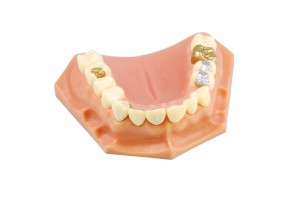Teeth that are damaged by decay (cavity) can be restored back to its normal function and shape with the help of a filling. Because a filling closes off spaces where more bacteria can enter, a filling will also help to prevent further decay. Fillings are also used to repair cracked or broken teeth as well as teeth that have been worn down from misuse (such as from nail-biting or tooth grinding).

What Are the Steps of the Treatment?
Prior to treatment, Inland Empire cosmetic and family general dentist will use a local anesthetic to numb the specific area around the tooth that needs to be filled. The next step entails the use of a drill, air abrasion instrument, or laser to remove the cavity. Dr. Naik will determine which particular piece of equipment will properly move the decay, which is based on multiple factors, such as the extent of the decay.
Once the decay has been completely removed, the space that requires filling will need to be prepared with a thorough cleaning. This means that there should be no remnants of bacteria and debris left in the space. Dr. Naik may need to protect the nerve with a special material (such as glass ionomer or composite resin) if the cavity is near the tooth root. After the filling has been made, the final restoration will be finished and polished. Dr. Naik can discuss the additional steps necessary for tooth-colored fillings with you during the consultation, if you are interested in that option.
What Are my Options with Filling Materials?
Today, there is more than one type of filling material available. You have several options, including: gold, porcelain, silver amalgam (which consists of mercury mixed with silver, tin, zinc, and copper); or tooth-colored, plastic, and glass materials called composite resin fillings. The type of material you choose for your filling is based on multiple factors, such as the location and extent of the tooth decay, personal budget (cost varies with each filling material) and insurance coverage, as well as Dr. Naik’s recommendation.
What Are The Benefits of Fillings?
There are specific said advantages (as well as disadvantages) with each filling material, which you may learn more about during your consultation at Moreno Valley Dental Care; however, the ultimate intent of a dental filling is to eliminate the discomfort and pain associated with a cavity.
When Would a Temporary Filling be Necessary?
Typically, under these certain circumstances, a temporary filling is necessary: before placement of gold fillings and fillings that use composite materials, after a root canal, if the pulp of the tooth nerve becomes irritated, when a toothache or another emergency dental treatment is needed.
Please note: temporary fillings are not meant to last. Within one month, they will likely fall out, fracture, or even wear out. In order to prevent infection and further complications, it is important that you know the lifespan and purpose of a temporary filling. The permanent filling will eventually replace it.
What is the Best Way to Properly Care for a Filled Tooth?
Being committed to good oral hygiene practices is a must when it comes to maintaining the quality of your fillings. This means regularly visiting the dentist for cleaning and brushing at home with a fluoride-containing toothpaste. You should also make it a point to floss at least once on a daily basis. If you start to notice that there is a crack or a piece missing in the filling, it is imperative that you schedule a dental appointment to have it checked out. Also, be sure to watch out for tooth sensitivity and sharp edges – additional signs of potential complications to watch out for.

